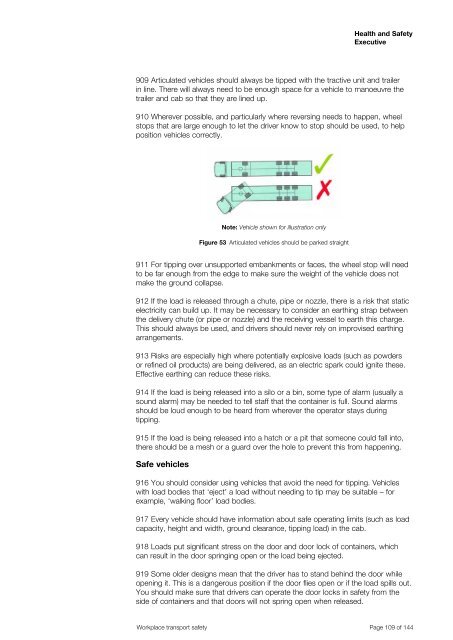Workplace transport safety An employers' guide - ARRI Lighting Rental
Workplace transport safety An employers' guide - ARRI Lighting Rental
Workplace transport safety An employers' guide - ARRI Lighting Rental
Create successful ePaper yourself
Turn your PDF publications into a flip-book with our unique Google optimized e-Paper software.
Health and Safety<br />
Executive<br />
909 Articulated vehicles should always be tipped with the tractive unit and trailer<br />
in line. There will always need to be enough space for a vehicle to manoeuvre the<br />
trailer and cab so that they are lined up.<br />
910 Wherever possible, and particularly where reversing needs to happen, wheel<br />
stops that are large enough to let the driver know to stop should be used, to help<br />
position vehicles correctly.<br />
Note: Vehicle shown for illustration only<br />
Figure 53 Articulated vehicles should be parked straight<br />
911 For tipping over unsupported embankments or faces, the wheel stop will need<br />
to be far enough from the edge to make sure the weight of the vehicle does not<br />
make the ground collapse.<br />
912 If the load is released through a chute, pipe or nozzle, there is a risk that static<br />
electricity can build up. It may be necessary to consider an earthing strap between<br />
the delivery chute (or pipe or nozzle) and the receiving vessel to earth this charge.<br />
This should always be used, and drivers should never rely on improvised earthing<br />
arrangements.<br />
913 Risks are especially high where potentially explosive loads (such as powders<br />
or refined oil products) are being delivered, as an electric spark could ignite these.<br />
Effective earthing can reduce these risks.<br />
914 If the load is being released into a silo or a bin, some type of alarm (usually a<br />
sound alarm) may be needed to tell staff that the container is full. Sound alarms<br />
should be loud enough to be heard from wherever the operator stays during<br />
tipping.<br />
915 If the load is being released into a hatch or a pit that someone could fall into,<br />
there should be a mesh or a guard over the hole to prevent this from happening.<br />
Safe vehicles<br />
916 You should consider using vehicles that avoid the need for tipping. Vehicles<br />
with load bodies that ‘eject’ a load without needing to tip may be suitable – for<br />
example, ‘walking floor’ load bodies.<br />
917 Every vehicle should have information about safe operating limits (such as load<br />
capacity, height and width, ground clearance, tipping load) in the cab.<br />
918 Loads put significant stress on the door and door lock of containers, which<br />
can result in the door springing open or the load being ejected.<br />
919 Some older designs mean that the driver has to stand behind the door while<br />
opening it. This is a dangerous position if the door flies open or if the load spills out.<br />
You should make sure that drivers can operate the door locks in <strong>safety</strong> from the<br />
side of containers and that doors will not spring open when released.<br />
<strong>Workplace</strong> <strong>transport</strong> <strong>safety</strong> Page 109 of 144
















